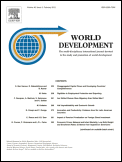Yes, it does.
At least, that is my answer to the question in a new article of mine titled “As You Sow, So Shall You Reap: The Welfare Impacts of Contract Farming,” which is forthcoming in World Development.
More specifically, I try to estimate the causal impacts of participation in contract farming — the economic institution in which a processing firm contracts its production of agricultural commodities out to grower households, or the first link in an agricultural value chain — on the welfare of the smallholders.
The major difficulty with studying such problems is that households are not randomly assigned to the treatment (i.e., participants in contract farming) and control (i.e., nonparticipants in contract farming) groups.
The smallholders who choose to participate in agricultural value chains do so following systematic patterns. The problem is that the researcher has no idea what those patterns are, as they often involve variables that are unobserved.
For example, it could be that more entrepreneurial smallholders are less likely to participate in agricultural value chains because they have better options. Or it could be that smallholders who are risk-averse are more likely to participate in agricultural value chains because contract farming partially insures them against income risk. But if it is difficult to measure risk aversion, it is even more difficult to measure entrepreneurial ability.

Contributing to Public Goods: My 20 Rules for Refereeing
The development economics blogosphere has been abuzz with talk of refereeing lately. Here are some words of advice from Quarterly Journal of Economics editor Larry Katz in an interview with Berk Özler on the Development Impacts blog, here is David McKenzie on the same blog, and here is Chris Blattman.
I cannot possibly claim to be among the best referees, but by my count, I have refereed
5657 papers and two book manuscripts since 2005, and I do take pride in my refereeing, which might explain why I was asked to become associate editor at the American Journal of Agricultural Economics for 2012-2015.As such, I figured I should chime in with my own advice about how to referee papers. I cannot say I always follow every single one of the 20 rules that follow but those are, by and large, the rules I try to live by as a referee. Some of those rules are derived from a similar list by Chris Barrett, who gave the students in his graduate empirical development micro class a list of such rules.
Because the following list is highly idiosyncratic, I would be very happy to hear about your own rules in the comments. And because this is a specialized post, I’m placing the list under the fold.